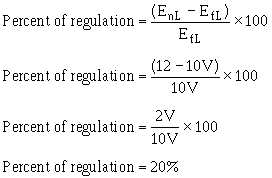3-35
receiver, the load on a particular power supply may depend on the brightness of the screen, the control
settings, or even the channel selected.
These variations in load resistance tend to change the applied dc voltage because the power supply
has a fixed internal resistance. If the load resistance decreases, the internal resistance of the power supply
drops more voltage. This causes a decrease in the voltage across the load.
Many circuits are designed to operate with a particular supply voltage. When the supply voltage
changes, the operation of the circuit may be adversely affected. Consequently, some types of equipment
must have power supplies that produce the same output voltage regardless of changes in the load
resistance or changes in the ac line voltage. This constant supply of power may be achieved by adding a
circuit called the VOLTAGE REGULATOR at the output of the filter.
LOAD REGULATION
A commonly used FIGURE OF MERIT for a power supply is its PERCENT OF
REGULATION. The figure of merit gives us an indication of how much the output voltage changes over
a range of load resistance values. The percent of regulation aids us in determining of the type of load
regulation needed. Percent of regulation is determined by the equation:
This equation compares the change in output voltage at the two loading extremes to the voltage
produced at full loading. For example, assume that a power supply produces 12 volts when the load
current is zero. If the output voltage drops to 10 volts when full load current flows, then the percent of
regulation is:
Ideally, the output voltage should not change over the full range of operation. That is, a 12-volt
power supply should produce 12 volts at no load, at full load, and at all points in between. In this case, the
percent of regulation would be:

